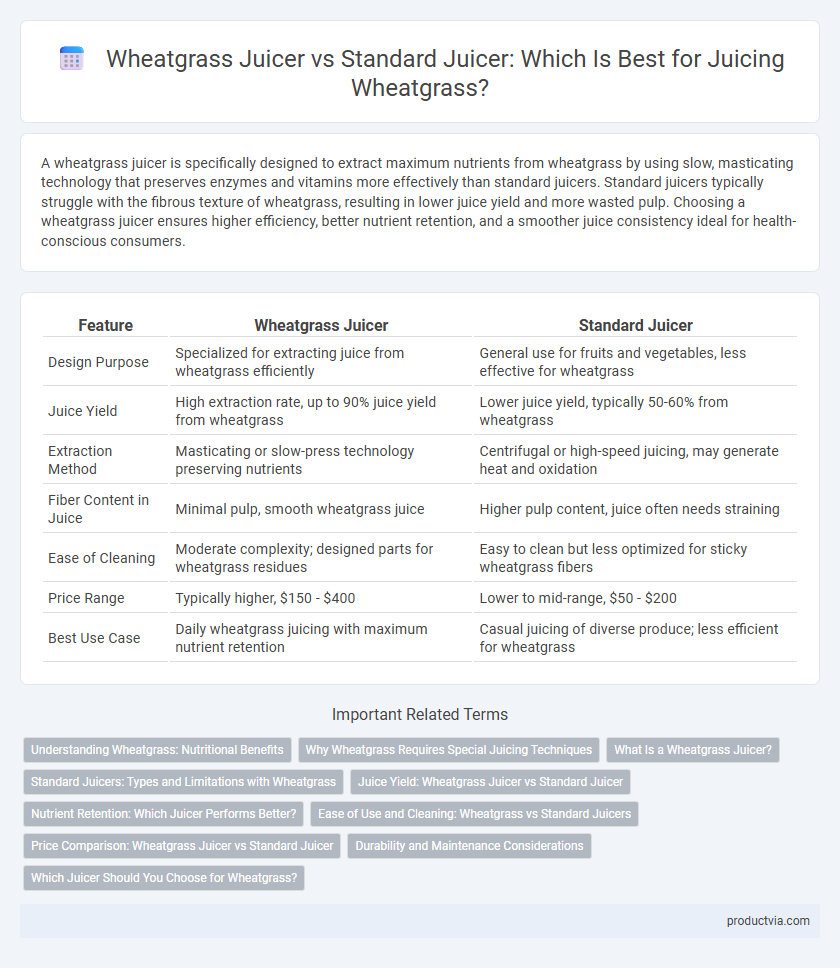A wheatgrass juicer is specifically designed to extract maximum nutrients from wheatgrass by using slow, masticating technology that preserves enzymes and vitamins more effectively than standard juicers. Standard juicers typically struggle with the fibrous texture of wheatgrass, resulting in lower juice yield and more wasted pulp. Choosing a wheatgrass juicer ensures higher efficiency, better nutrient retention, and a smoother juice consistency ideal for health-conscious consumers.
Table of Comparison
| Feature | Wheatgrass Juicer | Standard Juicer |
|---|---|---|
| Design Purpose | Specialized for extracting juice from wheatgrass efficiently | General use for fruits and vegetables, less effective for wheatgrass |
| Juice Yield | High extraction rate, up to 90% juice yield from wheatgrass | Lower juice yield, typically 50-60% from wheatgrass |
| Extraction Method | Masticating or slow-press technology preserving nutrients | Centrifugal or high-speed juicing, may generate heat and oxidation |
| Fiber Content in Juice | Minimal pulp, smooth wheatgrass juice | Higher pulp content, juice often needs straining |
| Ease of Cleaning | Moderate complexity; designed parts for wheatgrass residues | Easy to clean but less optimized for sticky wheatgrass fibers |
| Price Range | Typically higher, $150 - $400 | Lower to mid-range, $50 - $200 |
| Best Use Case | Daily wheatgrass juicing with maximum nutrient retention | Casual juicing of diverse produce; less efficient for wheatgrass |
Understanding Wheatgrass: Nutritional Benefits
Wheatgrass juicers are specifically designed to extract maximum nutrients from wheatgrass by using slow, masticating technology that preserves enzymes, vitamins like A, C, E, and chlorophyll content. Standard juicers, often centrifugal, tend to generate heat and introduce oxidation, resulting in nutrient degradation and lower juice yield from fibrous wheatgrass. Choosing a wheatgrass juicer ensures optimal extraction of antioxidants and essential minerals, maximizing the health benefits of this potent green superfood.
Why Wheatgrass Requires Special Juicing Techniques
Wheatgrass requires special juicing techniques due to its fibrous and tough cellulose structure, which standard juicers struggle to break down efficiently. Wheatgrass juicers utilize slow, cold-press masticating technology that preserves nutrients and extracts maximum juice without generating heat or oxidation. This method ensures higher chlorophyll retention and vital enzymes, providing superior health benefits compared to the higher-speed centrifugal action of standard juicers.
What Is a Wheatgrass Juicer?
A wheatgrass juicer is specifically designed to extract juice from tough, fibrous wheatgrass by using a slow, masticating or cold-press mechanism that preserves maximum nutrients and enzymes. Standard juicers, typically centrifugal, often struggle with wheatgrass due to high-speed spinning that generates heat and oxidation, resulting in lower juice yield and nutritional value. Specialized wheatgrass juicers optimize fiber separation and juice extraction, ensuring a richer, more potent wheatgrass juice compared to standard juicing appliances.
Standard Juicers: Types and Limitations with Wheatgrass
Standard juicers, including centrifugal and masticating types, often struggle with wheatgrass due to its fibrous texture and low juice yield. Centrifugal juicers tend to produce lower juice output and more foam, while masticating juicers perform better but still require frequent cleaning to prevent clogging. The unique structure of wheatgrass fibers demands specialized cold-press or twin-gear juicers to maximize extraction efficiency and nutrient retention.
Juice Yield: Wheatgrass Juicer vs Standard Juicer
Wheatgrass juicers are specifically designed to extract maximum juice from dense wheatgrass fibers, often yielding up to 30-40% more juice compared to standard juicers. Standard juicers, especially centrifugal models, struggle with wheatgrass's tough texture, resulting in lower juice yield and increased pulp waste. Using a wheatgrass juicer ensures efficient nutrient retention and higher juice volume tailored for wheatgrass extraction.
Nutrient Retention: Which Juicer Performs Better?
Wheatgrass juicers are specifically designed to maximize nutrient retention by using slow, cold-press extraction techniques that minimize oxidation and heat buildup, preserving vitamins, enzymes, and chlorophyll. Standard juicers, particularly centrifugal models, often generate heat and expose wheatgrass to more oxygen, which can degrade sensitive nutrients and reduce overall juice quality. Therefore, wheatgrass juicers outperform standard juicers in maintaining the highest levels of nutrient retention from fresh wheatgrass.
Ease of Use and Cleaning: Wheatgrass vs Standard Juicers
Wheatgrass juicers are specifically designed with slow masticating mechanisms that efficiently extract juice from the fibrous wheatgrass while minimizing residue, making them easier to use for this purpose compared to standard centrifugal juicers. Cleaning wheatgrass juicers is typically simpler due to fewer parts and less pulp accumulation, whereas standard juicers often require more disassembly and scrubbing because of their high-speed blades and mesh filters. This specialized design in wheatgrass juicers enhances user experience by reducing preparation and cleanup time during juicing sessions.
Price Comparison: Wheatgrass Juicer vs Standard Juicer
Wheatgrass juicers are specifically designed to efficiently extract juice from fibrous wheatgrass, often featuring slow masticating mechanisms, and generally cost between $150 to $400. Standard juicers, including centrifugal models, range from $50 to $300 but may struggle with wheatgrass due to less efficient fiber processing, leading to lower juice yield. Investing in a wheatgrass juicer offers higher efficiency and durability for wheatgrass extraction, whereas standard juicers provide a more affordable, though less optimal, alternative for occasional wheatgrass use.
Durability and Maintenance Considerations
Wheatgrass juicers are specifically engineered with durable, rust-resistant components to withstand the tough fibrous nature of wheatgrass, offering longer operational lifespan compared to standard juicers. Their maintenance involves regular cleaning of specialized parts designed to prevent clogging and ensure consistent juice extraction, reducing wear and tear over time. Standard juicers often struggle with wheatgrass fibers, leading to increased mechanical stress and more frequent repairs or replacements.
Which Juicer Should You Choose for Wheatgrass?
Wheatgrass juicers, often masticating or slow juicers, are specifically designed to efficiently extract juice from dense fibrous wheatgrass, providing higher yield and nutrient retention compared to standard centrifugal juicers. Standard juicers tend to generate heat and oxidation during fast spinning, which can degrade the delicate enzymes and reduce the overall nutritional benefits of wheatgrass juice. Choosing a dedicated wheatgrass juicer ensures optimal extraction, preserving enzymes, vitamins, and chlorophyll essential for maximizing health benefits.
Wheatgrass juicer vs standard juicer for wheatgrass Infographic

 productvia.com
productvia.com